Goats were one of the first species to be domesticated with records going back to neolithic times – and worldwide they are one of the truly multipurpose species, kept for milk, meat, fibre, harness, as pets, for weed control and pasture improvement, and for fuel using dried faeces. Even within the small population of goats in the UK, this multi-purpose benefit is evident in the very diverse goat sector.
It is estimated that worldwide there are around 1 billion goats kept, with over 10% of this total kept in China, and other large populations in India, Pakistan, Bangladesh and Nigeria (Food and Agriculture Organization of the United Nations, 2023). Within Europe, Greece has the largest population of goats at around 3.5 million, followed by Spain with 2.5 million and France at 1.5 million. Populations in both Greece and Spain have declined in the past 10 years (Eurostat, 2023). In comparison, the latest UK figure is 111 000 goats kept on a total of 11 250 holdings (Animal and Plant Health Agency, 2022), giving an average holding population of around 10 goats. Taken in isolation, however, these UK figures can give a false impression of the wide variation in herd size, and how and why goats are kept. This article describes the different types of goat-keeping within this small population. Goat demographic information and population maps for Great Britain are available, based on Animal and Plant Health Agency 2020–21 data (Animal and Plant Health Agency, 2022).
Records suggest that modern goats have all evolved from the wild Bezoar goat (or Bezoar Ibex) of the Zagros Mountains in Iran and Iraq, a species still found in the region today (Zeder, 2008; Daly et al, 2018). It is estimated that there are now over 300 distinct breeds of goat kept worldwide, many having been bred selectively to enhance a particular trait to increase productivity, quality or survivability. The most common breeds kept in the UK, as listed on the British Goat Society website, are:
- Anglo Nubian
- British Alpine
- British Guernsey
- British Saanen
- British Toggenburg (Figure 1)
- Golden Guernsey (Figure 2)
- Saanen
- Toggenburg
- Angora
- Bagot
- Boer
- Cashmere
- English
- Pygmy.
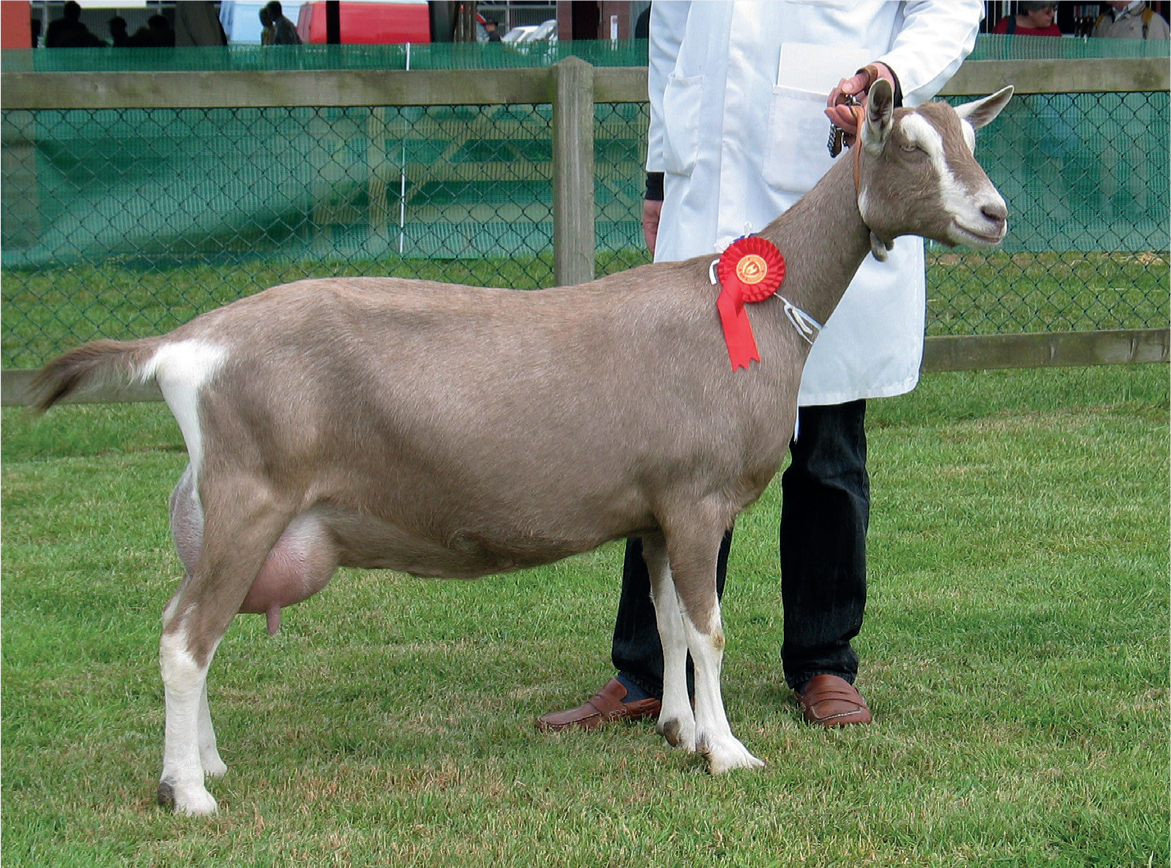
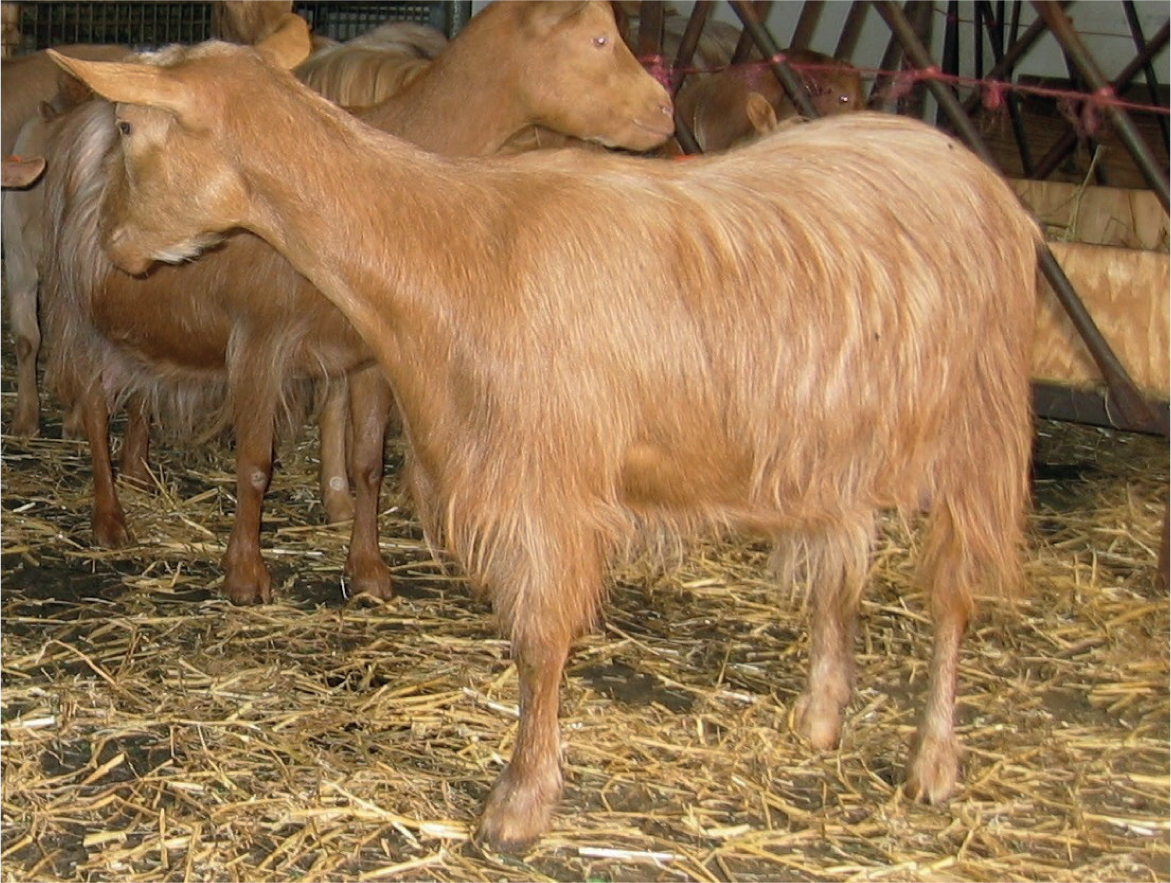
The British Goat Society, founded in 1879, states that one of its aims is ‘to improve the various breeds of goats, and especially to develop those qualities which are generally recognised and valued.’ The establishment of many of the breeds of dairy goats in Great Britain has largely been a result of the policies of this society. Breeding policies were based on performance data and gradually, with the help of imported goats, the breeds outlined above have evolved.
Pedigree and hobby sector
Underpinning all other areas of goat keeping within the UK are the true pedigree herds, and the British Goat Society and its various breed societies hold the pedigree and stud books and sell pedigree stock to more commercial herds for individual herd improvement. Pedigree goats are often exhibited at national and local shows (Figures 1 and 2), and any health planning advice should take this into account, as exhibition goats may well be visiting multiple agricultural shows through the show season, potentially mixing in close contact with goats from other holdings before returning back home again, with added biosecurity risks. Entry is often limited to British Goat Society registered goats, who need to show a valid British Goat Society caprine arthritis encephalitis certificate confirming that they belong to the British Goat Society monitored herd scheme.
Pedigree and hobby goats are generally kept on smallholdings or small farms (Figure 3). Some will be solely pedigree goat herds, some will have both pedigree and non-pedigree goats, and others may have goats running with sheep or other livestock species (Figure 4). The latter group needs well-structured veterinary advice, particularly with regard to nematode parasite control. Goats and sheep each require species-specific advice because of their differing susceptibilities and age-dependent resistance (Gascoigne and Dustan, 2019; Cooper, 2023).
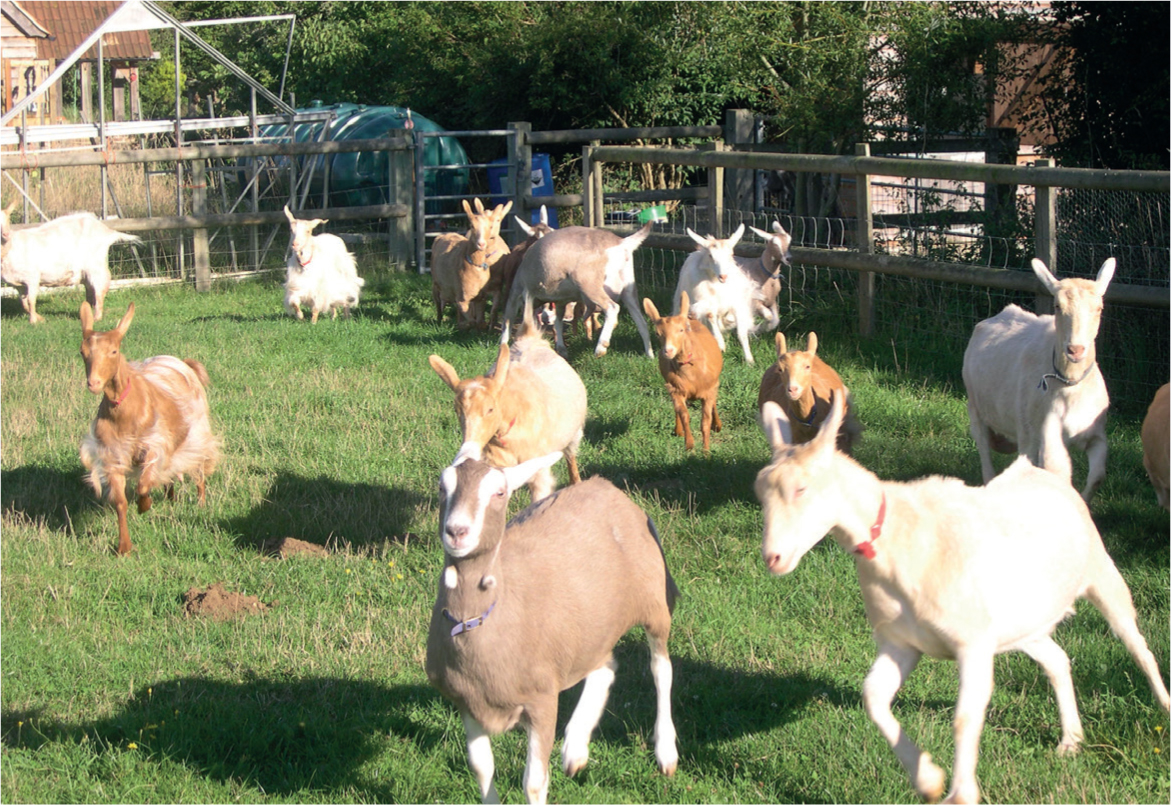
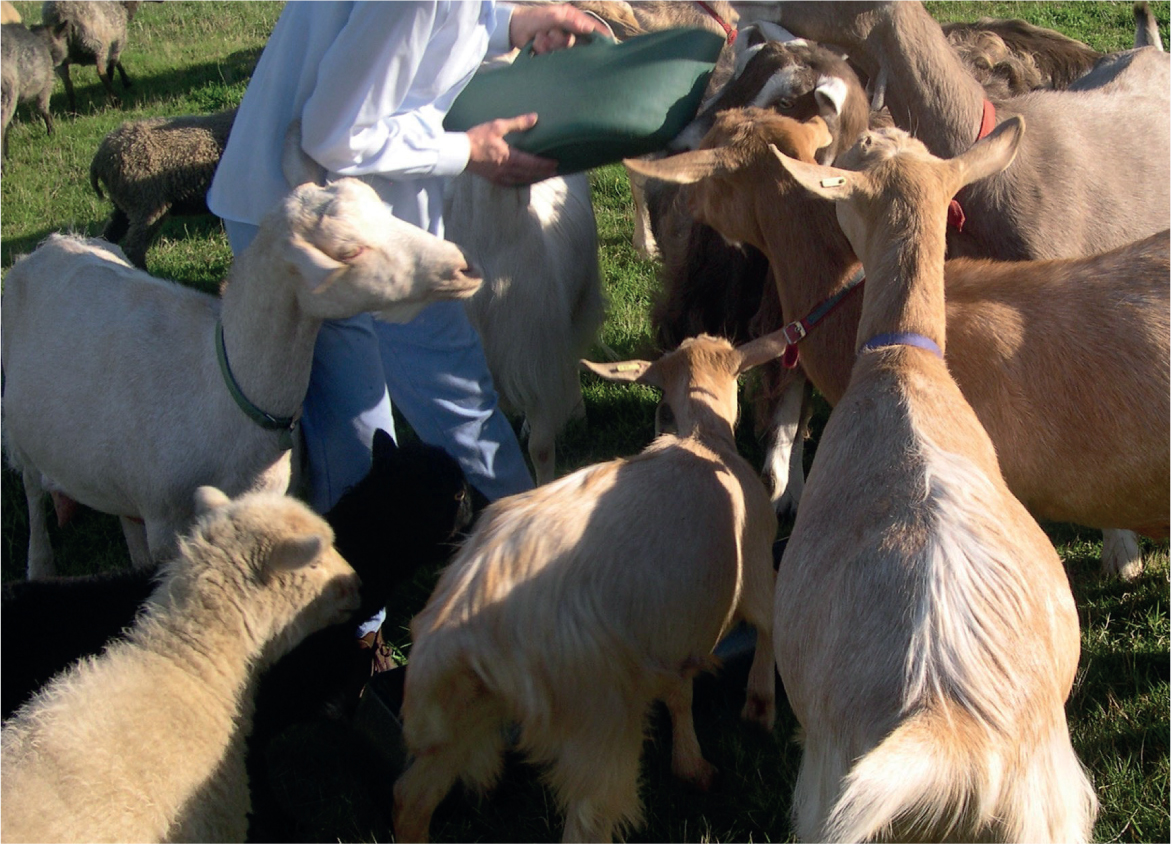
Commercial dairy goat keeping
This is by far the largest sector of goat keeping in terms of numbers, with an estimated population of approximately 45 000 milking females on around 120 commercial units (Figure 5), plus followers. Herd size varies, up to a maximum of 6000 on a single holding. Most of these herds are housed all the time, predominantly because goats have only limited age-dependent resistance to gastrointestinal nematodes. Feeding regimens will vary, but a total mixed ration based on grass and maize silage is most common.
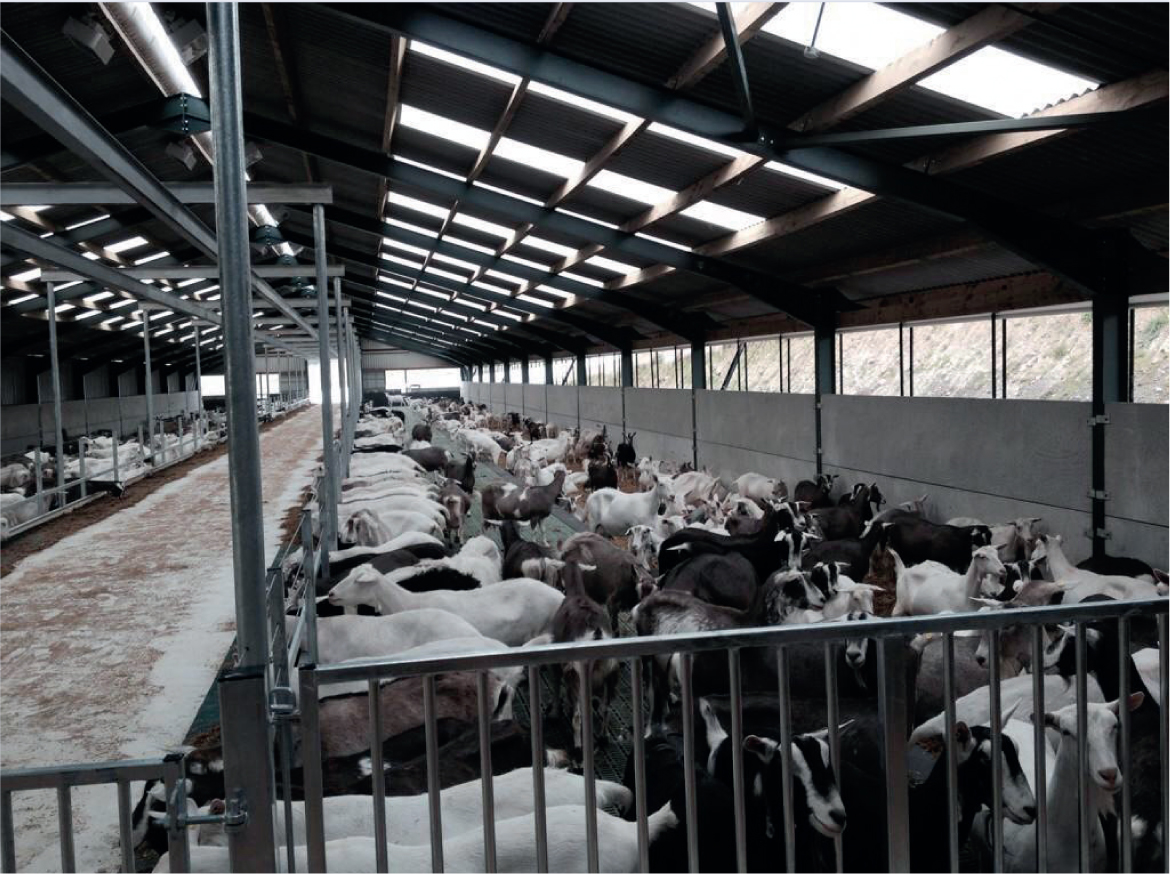
Breeding
There has been a move in recent years to reduce the age of maiden goats at first service. It is estimated now that over 70% are first bred at around 7 months of age to kid down at 12 months, with the remainder bred between 8 and 12 months old (C Whitehouse, personal communication, 2023). When mature, yields vary with herd average milk yields between 800 and 1400 kg per annum (K Wielkopolski, C Whitehouse, personal communication, 2023). As the market is relatively small, yields have to be managed to balance supply on farm with demand from customers. In recent years there has been an increasing focus on extending lactation length with a proportion of the herd only kidding once every 18 months or longer; goat lactations can continue for up to 4 years. By reducing the frequency of kidding, and hence the overall number of kids born, there will be fewer male kids that may need culling as being surplus to requirements and thus a positive animal welfare benefit.
As goats are seasonal breeders, out of season service is achieved via either the use of hormones, for example, Regulin (Ceva) or by manipulation of day length. This management procedure varies from farm to farm and year to year depending on the wholesale milk market and milk price. Very little artificial insemination was initially available across the sector, although this is becoming more widely used. It is often only used in a proportion of does in the herd with a view to achieving more rapid genetic improvement. Research is ongoing into the use of sexed semen via artificial insemination to further reduce the number of males born.
Goat's milk market
The commercial goat milk market peaked in 2018, and the overall demand for goat's milk products has reduced (Kelly, 2023). Cow's milk has seen a significant increase in price, primarily because of the lack of supply compared to demand. Goat's milk products already start at a much higher price point than cow's milk products, so retailers have been reluctant to push through any price increases on the shelf. Where prices have been increased, there has been a noticeable drop in demand as a result. The cost of living has become a real issue for many consumers, which could impact demand further as higher priced goods such as goat's milk products will be swapped for lower priced items by the consumer (Kelly, 2023).
In addition, there is competition from other products such as oat, almond and soya milk alternatives. One such brand is now the fourth most popular brand in the milk and milk alternatives market, reporting a 91% increase in sales in 2020 (Kelly, 2023).
Diseases
The common endemic diseases and conditions recognised in goats in the UK can develop equally across the goat population and within the different sectors. However, because of the management and feeding systems used in the commercial sector, there are some specific problems to consider:
- Johne's disease – this can rapidly become established if introduced, because of the housed management system. Pugh (2019), in a survey of eleven commercial dairy herds covered by a UK veterinary practice, concluded that over half of these herds showed a high presence of infection based on Johne's PCR (polymerase chain reaction) testing. The Gudair vaccine (Virbac) is widely used, and the sector, with veterinary advice, initially developed and shared its own Johne's disease control plan internally between its producers. This has been further developed into various farm assurance scheme recommendations. The Premium Sheep and Goat Health Scheme's Johne's scheme is available. Originally developed for the cattle and sheep sectors, and now extended to the goat sector, it provides guidance and laboratory testing protocols to monitor and control Johne's disease.
- Conditions such as scrapie (Konold et al, 2020), tuberculosis, caseous lymphadenitis and caprine arthritis encephalitis can spread rapidly when introduced to a susceptible herd housed together in close proximity. Whole herd slaughter as a result of high within-herd levels of scrapie (Konold et al, 2020) and tuberculosis (Department for Environment, Food and Rural Affairs, 2022a) has been necessary.
- Listeriosis can be a problem in silage-fed herds with similar risk factors to those in dairy cow herds (poorly made or stored silage, not removing uneaten silage and allowing it to spoil).
- Compared to dairy cow herds, clinical mastitis is not a common problem. Somatic cell counts are much higher, in part because of the physiological differences in milk synthesis at the cellular level in the udder. Milk synthesis in goats is apocrine (as opposed to merocrine in cattle), a process that results in a high number of round cytoplasmic particles and epithelial cells in the milk (Park and Humphrey, 1986). Paape et al (2001) described individual somatic cell counts for goats free from intramammary infection ranging from 270 to 2000x103/ml; these data are supported by the author's personal observations. Because of low levels of clinical mastitis reported across the sector, routine dry goat therapy is generally inappropriate (C Whitehouse, personal communication, 2023). A commercial mastitis vaccine (Vimco, HIPRA) is available and has marketing authorisation for use in milking goats. It is marketed for the immunisation of healthy female goats in herds with recurring mastitis problems, to reduce the incidence of sub-clinical mastitis caused by Staphylococcus aureus and/or coagulase-negative Staphylococci.
- Foot overgrowth should be monitored on a regular basis and trimmed if necessary, when kept on deep litter, and care should be taken to prevent the introduction of footrot as this can spread rapidly in housed herds, with severe consequences. In one herd investigated by the author, up to 50% of adult goats in one yard were affected, response to treatment was disappointing and many of these were culled on humane grounds (D Harwood, personal observations, 2006).
A sector assurance scheme has been in operation since 2005 but was taken over by the Red Tractor Farm Assurance Scheme in November 2021.
The sector developed its own representative body, the Milking Goat Association (https://www.milkinggoat.org.uk/), established in 2016. Through this association, the industry is continually looking ahead at significant development in areas such as artificial insemination and genomics, disease control and reducing mortality, and kid-rearing protocols. Herds of <200 pay a flat-rate annual fee, herds of >200 pay via a milk levy. Two of its main aims are:
- To bring together research and development from farm level and academic researchers, and to distribute it to the wider industry to increase productivity, and promote welfare and sustainability of the overall industry
- Provide an associated body to take issues to government and the wider industry, such as livestock health status and awareness of industry.
Meat goats
Accurate data on the number of goats raised and slaughtered for meat are not readily available, but the sector itself suggests that the figure is around 18 000–19 000 per annum in the UK. This figure is largely supported by a Food Standards Agency snapshot survey undertaken in March 2022 (Department for Environment, Food and Rural Affairs, 2022b).
There are two main types of meat holdings. One focuses on breeding and rearing the Boer goat and Boer cross goats (Figure 6), a breed of South African goat known for its rapid growth and good carcass characteristics. The remainder mainly source male kids from the dairy goat sector (Figures 7 and 8) and either fatten them on site or at dedicated rearing and fattening units.
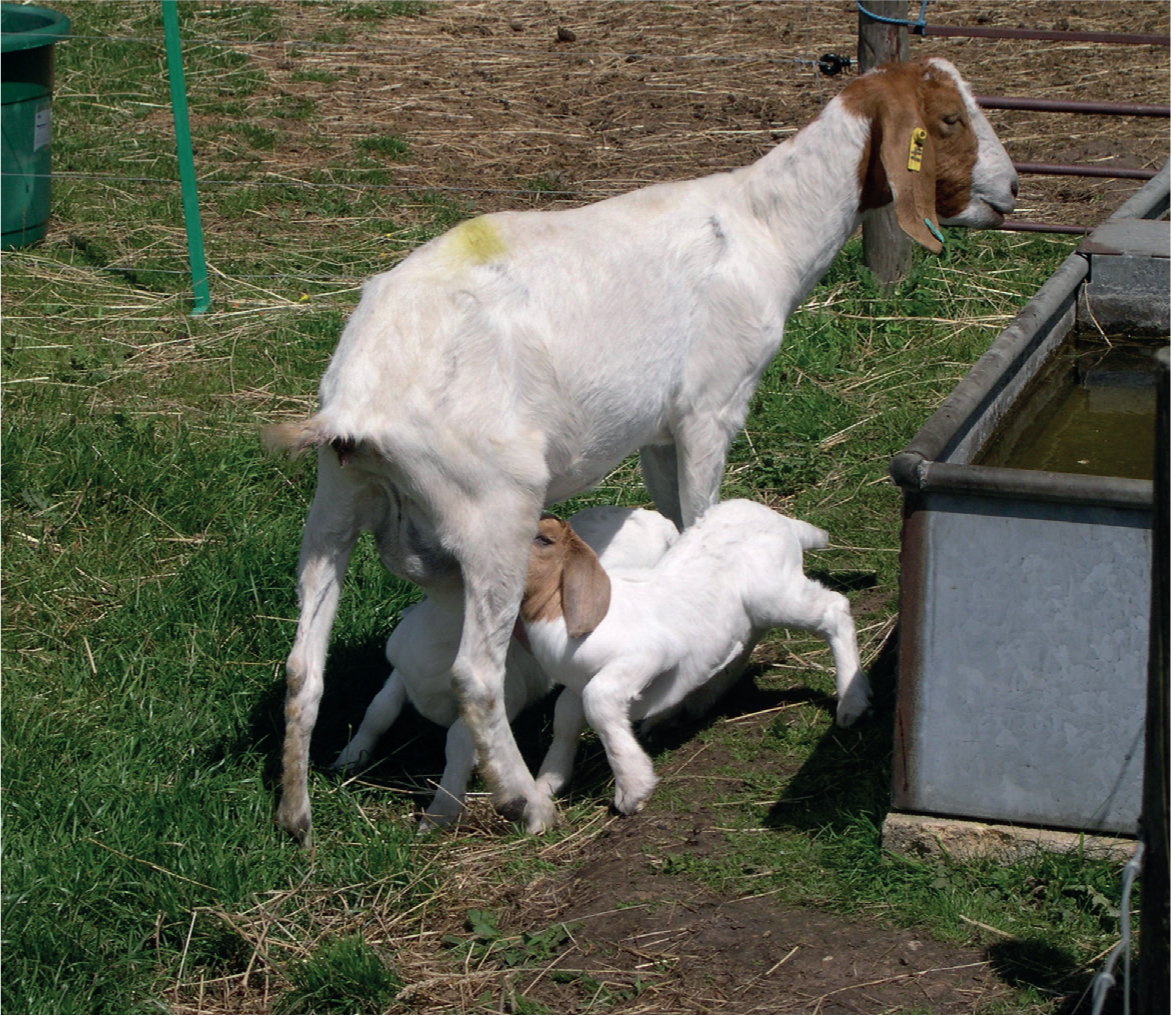
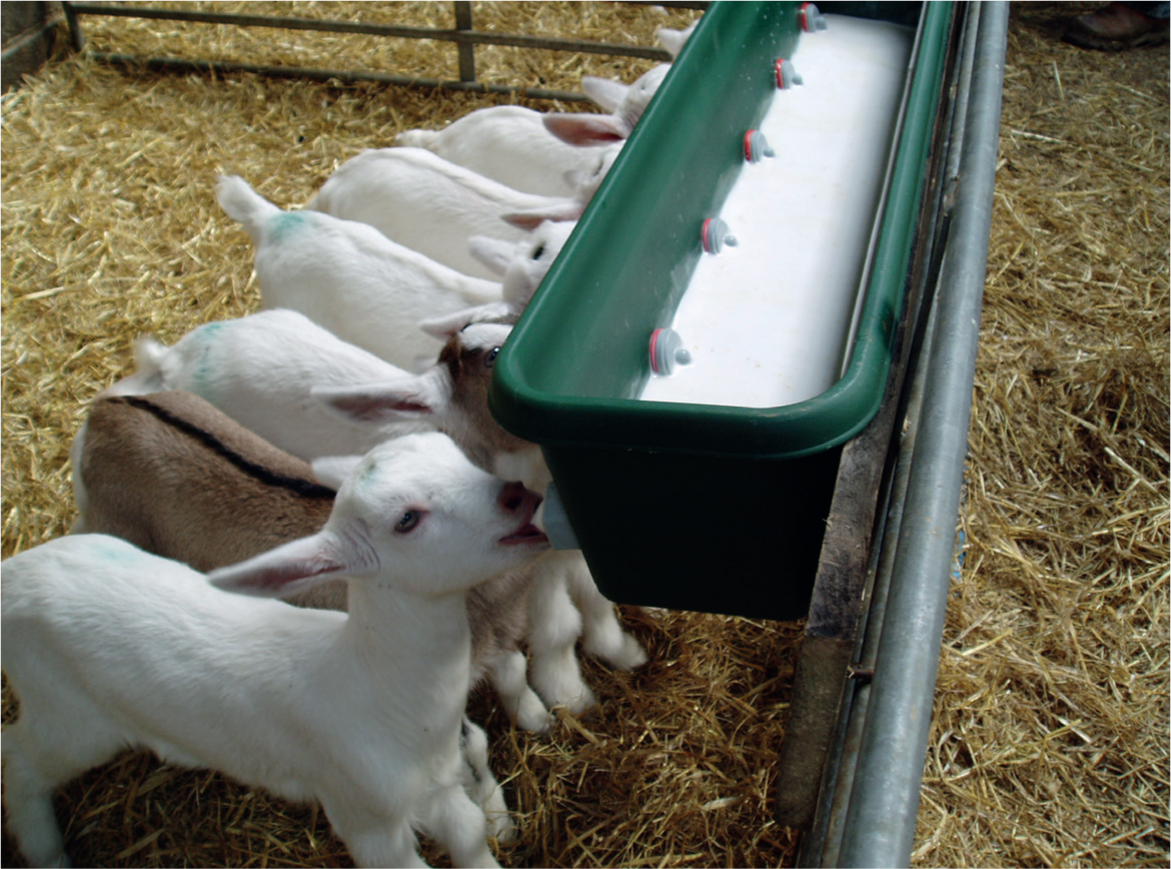
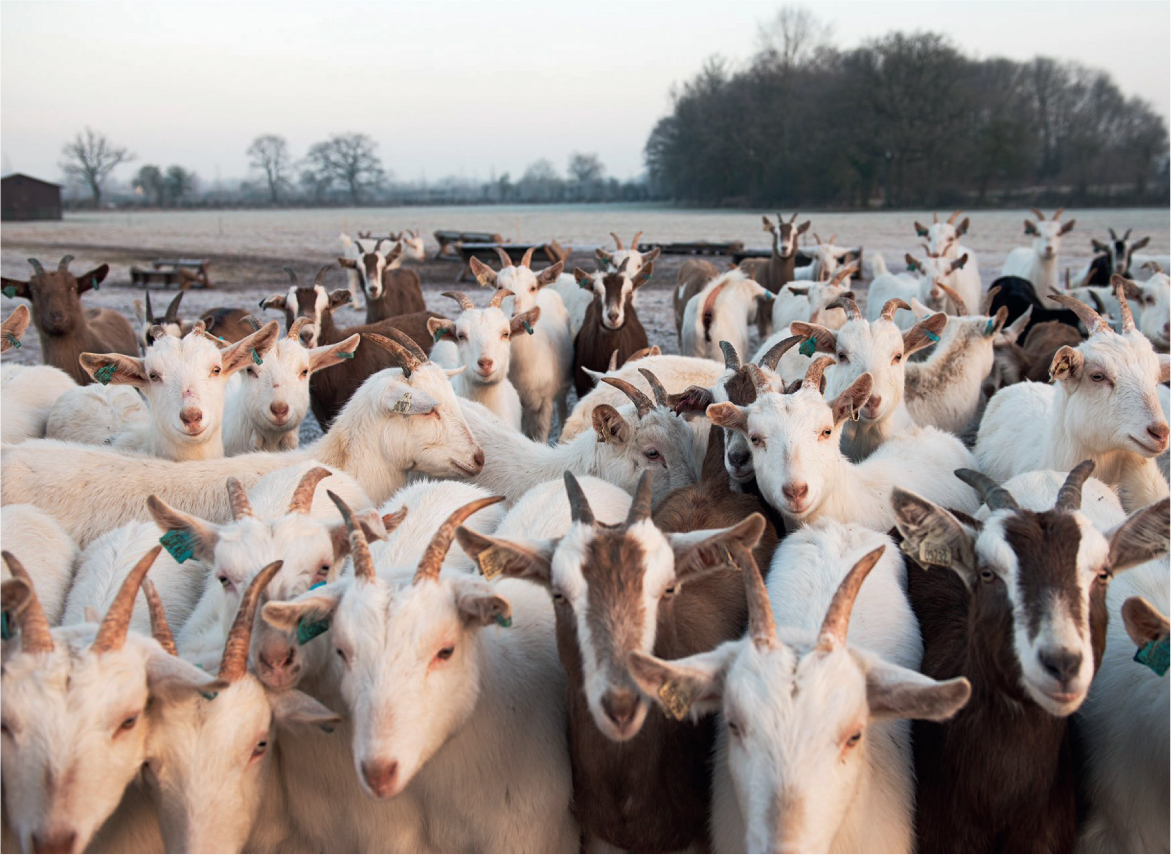
Nematode parasitism has been a particular problem for this sector, with cyclical exposure and increasing pasture contamination having a detrimental effect on growth rates and the maintenance of current organic principles, and many meat goats are now fattened indoors. With careful planning, however, a small number of producers have overcome the problem and are successfully rearing and fattening goats outdoors.
As the sector is small, the market has tended to be via internet sales, farmers markets and restaurants. In comparison to red meats, goat meat has a reputation as a healthy meat alternative. It is low in fat, cholesterol, calorific energy and saturated fat (50% lower in fat than beef and around 40% lower in saturated fat than chicken) (Haytowitz et al, 2019). The demand for more mature cull goat meat is greater among a number of ethnic communities around the country.
Fibre goats
As with the meat sector, accurate population data are lacking, although the population has remained fairly static and it is estimated that between 5000 and 7000 goats are kept and reared purely for their fibre (Mason, 2009; British Angora Goat Society, 2023). The predominant breed is the Angora, producing mohair. These goats are sheared twice a year, usually in January and late summer. As the fleece grows, it forms ‘ringlets’ or staples, with a spiral twist known as style and a crimp known as character. The length, lustre, density, quality, fineness and evenness of the fleece are all-important, a product of heredity and management.
Cashmere goats are goats that produce a specific type of fibre termed cashmere, not a specific breed (Figure 9). Commercial cashmere is produced by a number of goat breeds including dairy breeds (usually crosses). Historically, the Kasmir goat gave its name to the fibre. Cashmere grows from secondary follicles in the skin with the fibre less than 18.5 microns diameter; the best goats produce cashmere fibre less than 14.5 microns. The rate of fibre growth is quite variable, with a minimum growth of about 4 cm in 12 months but around twice this in improved stock (Mason, 2009). These goats are also very good at pasture improvement.
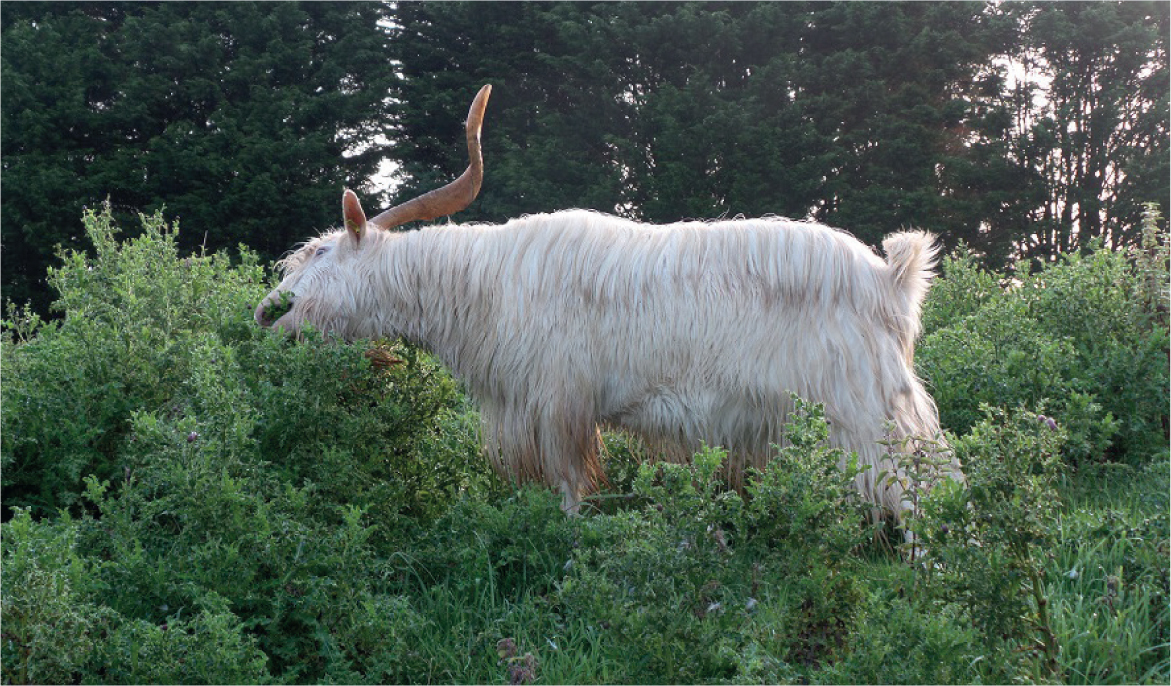
Pets and public attractions
Owing to their gentle demeanour and gregarious nature, goats make excellent animals to keep at public attractions (Figure 10), particularly where there is interaction with young children. Any breed or type of goat can be kept, but the Pygmy goat breed is most common, in particular because of its size. Some larger attractions source regular supplies of surplus neonatal male kids from local dairy units for visiting children to bottle feed throughout the year, before moving them on to be fattened. Points to bear in mind with this type of enterprise are:
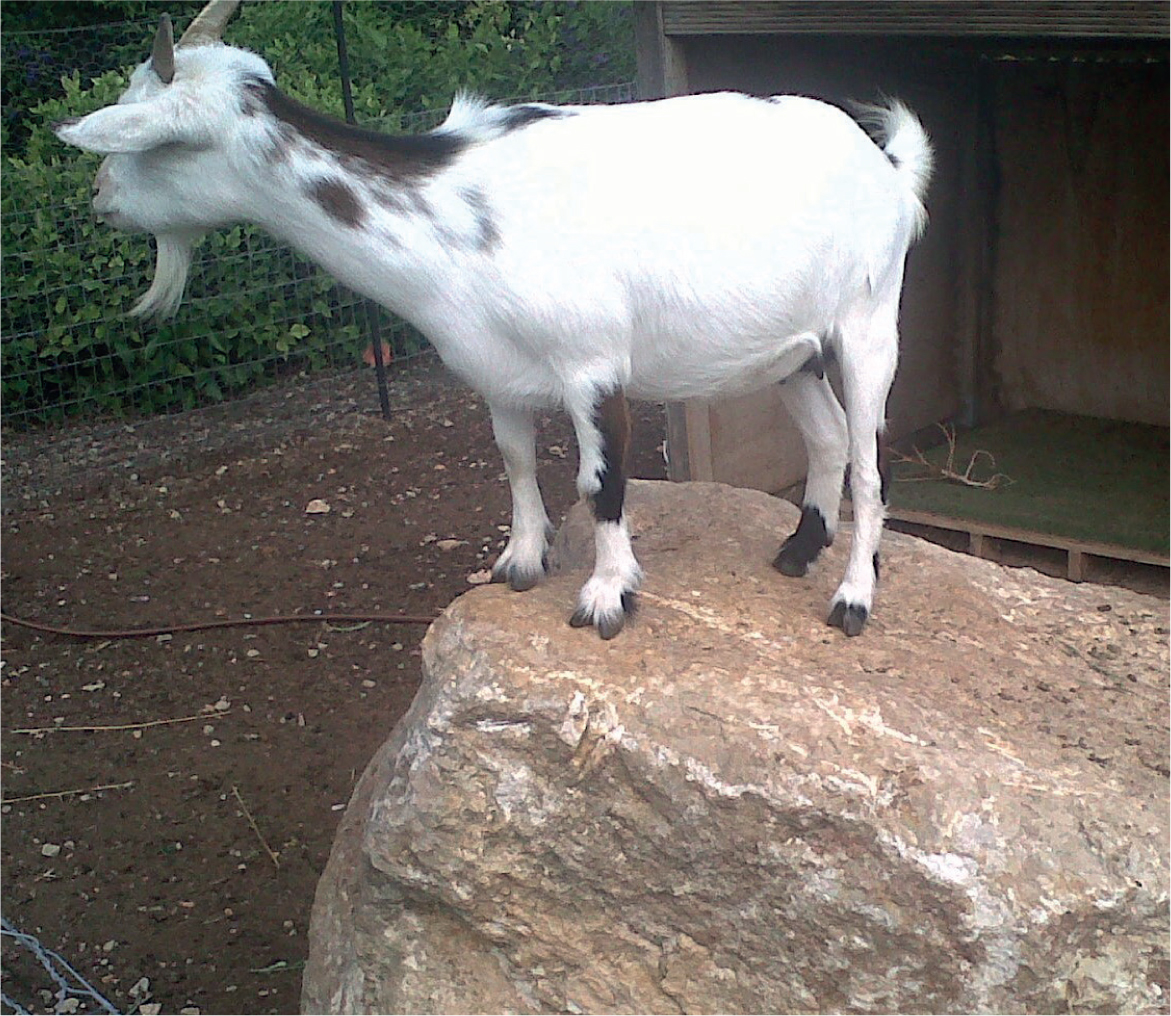
- Goats are social herd animals that do not usually cope well with being kept singly. Potential owners must therefore consider their duty of care under the Animal Welfare Act 2006 and provide goats with suitable social companionship. Owners should plan to allow at least two goats that get on well to live together. Ideally it is best to acquire two or more goats from the same herd that are already companions
- Remember that all goats are classified as farm animals, regardless of how they are kept – and as such all relevant legislation applies, as does their susceptibility to notifiable diseases such as tuberculosis. All goat owners must comply with the relevant legislation governing goat identification, movements and holding registration. Guidance for owners of domestic goats in England and Scotland on tuberculosis, how and why the disease is tested and what happens if tuberculosis is detected in goats can be found on the Animal and Plant Health (2014) website
- Any fencing must be secure to ensure that the goats do not escape
- Zoonotic diseases become of greater importance when children are regular visitors:
- The two most significant pathogens are Cryptosporidium parvum and Escherichia coli O157 – both of which have been linked to outbreaks of infection in children visiting farms open to the public
- Goats carrying these pathogens may appear healthy, so it is important to reduce the risk of faecal transfer from the goat environment to visitors, while accepting that visitors can never be free from all risk. However, implementing effective control measures will help ensure that the risk of infection from contact with animals is low
- Suitable hand washing facilities should be provided, sufficient for the expected number of visitors needing to use them at any one time. These should include running water (preferably warm), soap and paper towels, with suitably placed signs emphasising the risks and directing visitors to the nearest hand washing post
- Further information is available on the Health and Safety Executive (2023) website
- A code of practice has been produced by the industry, aimed at the owners, operators and managers of such visitor premises (Access to Farms, 2021). It provides guidance, including pictures and real-life case studies, of practical measures that can be applied at such premises thus ensuring that the owner (with relevant veterinary advice if needed) can comply with the law and keep visitors safe
- Other goat-related zoonotic risks include goats exhibiting signs of orf and goats that are aborting or kidding – these goats should be kept away from the visiting public
- Owner aspirations will be very different to those of owners keeping goats for profit. Johne's, caseous lymphadenitis, caprine arthritis encephalitis and other endemic conditions can all become established, but owners in this category may be more willing ‘to live with and manage’ the disease rather than develop a test and cull programme
- As these goats will often ‘live out their lives’, some more unusual neoplasias may be encountered, including thymic lymphosarcoma, mammary adenocarcinoma, fibrosarcoma and neoplasia of the female reproductive tract (author's personal observations)
- Older goats are prone to chronic laminitis with pedal bone rotation, and to degenerative osteoarthritis of limb joints (Matthews, 2012).
Wild goats
There are several ‘herds’ of feral goats around the UK that have adapted their browsing behaviour to benefit local conservation initiatives and maintain areas of scrubland. During the COVID-19 lockdown these goats came to prominence, when the wild herd Kashmiri goats came down from the Great Orme in North Wales into Llandudno town centre.
Conclusions
All goats are ruminants, and as such, there are many similarities with both sheep and cattle management systems in the UK. One major difference is that goats are browsing and not grazing ruminants, and with such a small number in comparison, they are also classified as a minor species. This article has hopefully informed the reader of the wide variation in goat keeping management systems, purpose and owner aspirations in relation to ensuring their health and welfare.
KEY POINTS
- The UK goat population of around 111 000 is small in comparison to the sheep and cattle populations, and as such goats are considered a minor species.
- They are kept for a wide variety of reasons from commercial milk production to fibre production, and from meat goats to pet goats.
- Some goats are kept for profit, others as beloved pets – as such owner aspirations regarding disease control will vary considerably.
- Goats are often kept with other species and any health planning advice should recognise the specific requirements of goats, for example in terms of nematode parasite control.
Further information
- Goat Veterinary Society - https://www.goatvetsoc.co.uk
- British Goat Society - https://www.britishgoatsociety.com
- Milking Goat Association - https://www.milkinggoat.org.uk/
- Premium sheep and goat health scheme - https://www.sruc.ac.uk/business-services/veterinary-laboratory-services/sheep-goat-health-schemes/premium-sheep-goat-health-schemes/
- Harwood DG, Mueller K. Goat medicine and surgery. 2018. CRC Press, Taylor Francis Group.


